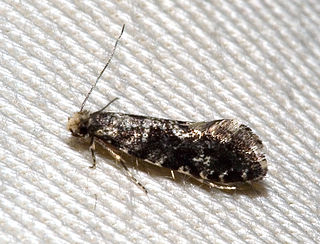
Tineidae is a family of moths in the order Lepidoptera described by Pierre André Latreille in 1810. Collectively, they are known as fungus moths or tineid moths. The family contains considerably more than 3,000 species in more than 300 genera. Most of the tineid moths are small or medium-sized, with wings held roofwise over the body when at rest. They are particularly common in the Palaearctic, but many occur elsewhere, and some are found very widely as introduced species.
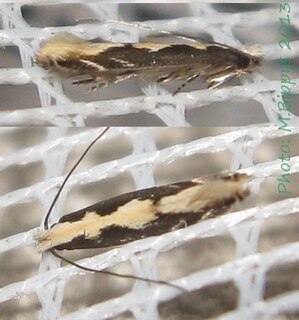
Amphixystis is a genus of moths belonging to the family Tineidae. The family was first described by Edward Meyrick in 1901.

Proterodesma is a genus of moths belonging to the family Tineidae. All the species in this genus are endemic to New Zealand.

Habrophila is a genus of moths belonging to the family Tineidae. This genus was described by Edward Meyrick in 1889. It consists of only one species, Habrophila compseuta, which is endemic to New Zealand.

Tephrosara is a genus of moths belonging to the family Tineidae. It contains only one species, Tephrosara cimmeria, which is endemic to New Zealand.
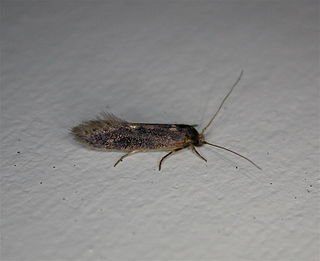
Opogona omoscopa is a moth of the family Tineidae.

Erechthias chionodira is a species of moth in the family Tineidae. It was described by Edward Meyrick in 1880 using two specimens obtained in Auckland on a shady bank amongst forest in January. This species is endemic to New Zealand.

Archyala opulenta is a species of moth of the family Tineidae. This species is endemic to New Zealand has been found in the upper Maitai Valley in Nelson as well as in Northland. The larvae of this species are associated with endemic bat species as they feed on the guano of Mystacinidae. The adult moths are on the wing in November. It is classified as "Data Deficient" under the New Zealand Threat Classification System by the Department of Conservation.

Archyala terranea is a species of moth in the family Tineidae. It was described by Arthur Gardiner Butler in 1879. This species is endemic to New Zealand. This species has been recorded as being on the wing from December to February.

Astrogenes chrysograpta, is a species of moth in the family Tineidae. It was described by Edward Meyrick in 1921 using a specimen collected by Stella Hudson on Mount Arthur in January. This species is endemic to New Zealand.

Uromycladium tepperianum is a rust fungus that infects over 100 species of Acacia and related genera including Paraserianthes in Australia, south-east Asia, the south Pacific and New Zealand. The acacia gall rust fungus species Uromycladium tepperianum has been introduced to South Africa as a biological control on the invasive Australian shrub Acacia saligna.

Erechthias crypsimima is a species of moth in the family Tineidae. It was described by Edward Meyrick in 1920 using a specimen collected by George Vernon Hudson in Wellington in February. This species is endemic to New Zealand. Hudson noted that he collected the type specimen of this species from the black trunk of a beech tree.

Lysiphragma epixyla is a species of moth in the family Tineidae. It is endemic to New Zealand. It was described by Edward Meyrick in 1888 using specimens collected from Wellington, Lake Wakatipu and Invercargill in December and January. Meyrick notes that this moth can usually be found at rest on tree trunks. This species is endemic to New Zealand.
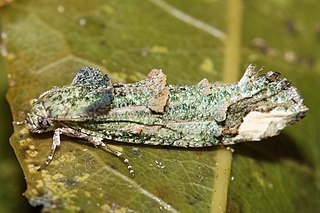
Lysiphragma mixochlora is a species of moth in the family Tineidae. It was described by Edward Meyrick in 1888. This species is endemic to New Zealand.

Tinea belonota is a species of moth in the family Tineidae. It is endemic to New Zealand. It is classified as not threatened by the Department of Conservation.
Tinea dubiella is a species of moth belonging to the family Tineidae.
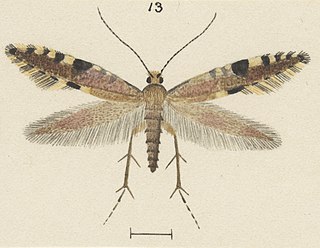
Tinea munita is a species of moth in the family Tineidae first described by Edward Meyrick in 1932. However the placement of this species within the genus Tinea is in doubt. As a result, this species may be referred to as Tinea (s.l.) munita. This species is endemic to New Zealand.

Prothelymna antiquana is a species of moth in the family Tineidae first described by Francis Walker in 1863. This species is endemic to New Zealand.
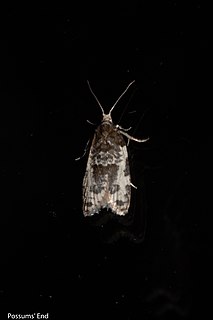
Prothelymna niphostrota is a species of moth in the family Tineidae first described by Edward Meyrick in 1907. This species is endemic to New Zealand.

Prothelymna potamias is a species of moth in the family Tineidae first described by Edward Meyrick in 1909. This species is endemic to New Zealand.



















